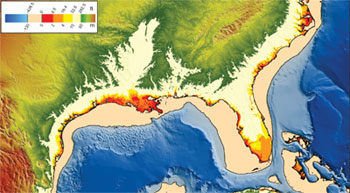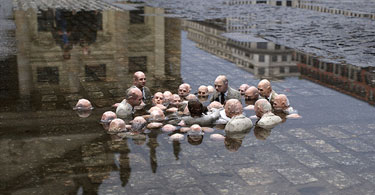Today, the White House released the National Climate Assessment, the most comprehensive effort yet on how climate change is impacting every region of the US, and what to expect going forward.
To get the word out to Americans, President Obama is taking a novel approach – he’s holding interviews with television weathercasters, hoping they will communicate the data across the country. People trust meteorologists because they hear them every day.
His interview with Al Roker, for example, airs tomorrow on NBC’s TODAY and will be on its website afterwards.
This is the third National Climate Assessment, required every four years under a law passed in 1990. It is prepared by 300 scientists under the US Global Change Research Program, a collaboration of 13 federal departments and agencies.
The report is the "loudest and clearest alarm bell to date," says John Holdren, White House Science Advisor.
"Evidence for climate change abounds, from the top of the atmosphere to the depths of the oceans," says the report. "Evidence is also visible in the observed and measured changes in location and behavior of species and functioning of ecosystems."
"One major take-home message is that just about every place in the country has observed that the climate has changed. It is here and happening, and we are not cherrypicking or fearmongering," Gary Yohe, economist at Wesleyan University and vice-chair of the advisory committee for the National Climate Assessment, told The Guardian.

Climate-deniers continue to call the report a "scare tactic", but you can see for yourself what’s happening in your region (if you don’t have a window!). The report contains graphics and interactive maps that depict the threats specific to seven US regions and you can find projections for your state – how many days each year will exceed 95 degrees, heavy downpours or drought.
What can each region expect? While all regions will get much warmer for longer periods of time:
- Northeast: more and stronger floods
- Southeast: flooding and more intense hurricanes
- Midwest: a longer growing season, but crops are much more vulnerable from volatile weather
- Southern Plains: more drought
- Northern Plains: heavier, more frequent precipitation
- Southwest: more drought
- Pacific Northwest: more frequent, intense wildfires and decreases in snowpack even though there’s more precipitation
The goal is to help communities plan, but also to bring the situation home to people to instill a sense of urgency.
But nothing fazes the pollution industry: "Facing a recovering, yet fragile, economy, with families across the country struggling to make ends meet, it is concerning that the Obama Administration is busy promoting its politically driven climate change agenda, instead of addressing the real issues plaguing our nation," said Laura Sheehan, of the American Coalition for "Clean Coal."
This is the same industry that’s suing the EPA for stronger coal dust standards to prevent disease in coal miners.
L
Highlights from the report:
- Climate change, once considered an issue for a distant future, has moved firmly into the present;
- Average US temperatures are 1.3-1.9 degrees F higher than 1895, mostly since 1970. The most recent decade is the hottest on record and 2012 was the hottest year ever recorded in the US;
- Global sea levels are about 8 inches higher than in 1880 and will rise 1-4 feet more during this century.
"Long-term, independent records from weather stations, satellites, ocean buoys, tide gauges, and many other data sources all confirm the fact that our nation, like the rest of the world, is warming, precipitation patterns are changing, sea level is rising, and some types of extreme weather events are increasing."
Last time the National Climate Assessment was released, in 2009, The International Energy Agency (IEA) also released a stern warning: "There is still time to act, but the window of opportunity is closing."
"If we do not have an international agreement whose effect is put in place by 2017, then the door will be closed forever," IEA Chief Economist Fatih Birol warned.
The IPCC report, released last month confirms those concerns.
More Scary Evidence Emerges
Sea Level Rise: In 2011, scientists noticed a crack in one of the largest icebergs in Antarctica, and last November, it broke free and is now floating in the Southern ocean. The enormous sheet of ice is extends over 255 square miles and is about a third of a mile thick.
Ocean Acidity: Off the coast of the Pacific Northwest, scientists have found the first evidence of the effects of acidifying oceans: it is dissolving the shells of pteropods – a critical food source at the bottom of the food chain. Without it, fish are in trouble.
"These are alarm bells … we can actually see the shells dissolving right now," Nina Bednarsek, a scientist with the National Oceanic and Atmospheric Administration, told Mercury News. 53% of pteropods have several dissolving shells.
Methane Release: 71 wetlands around the world are becoming "fens" from melting permafrost, part of the reason methane has been spiking in the atmosphere since 2007, reports Climate Central.
President Obama’s View
Climate change has been a back seat to other priorities, but now Obama is laser-focused on it, according to his advisers.
He regularly receives briefings on scientific reports and routinely brings up the subject with other world leaders, they say. He also talks about it a lot with his family, reports Washington Post.
During the depths of the recession, it was difficult to push climate policy when Americans were so anxious about the economy. Then there was the fracking boom, and although Obama embraced it as a transition to renewable energy, he’s also been concerned about methane emissions. That resulted in the Methane strategy announced in March.
Another problem is the result of a massive misinformation campaign by the Koch Brothers, which succeeded in confusing Americans about the reality of climate change. Amazingly, even though disasters now impact everyone, climate change ranks low on voter priorities in polls.
Therefore, Obama included climate change in his second inaugural address – a big surprise at the time because it had barely been mentioned until then. Then came his Climate Change speech.
Here is an overview of the report, a video that describes the conclusions, and Obama’s action plan:

